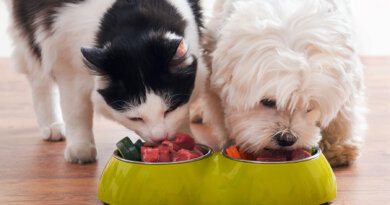Here is what the Pet Food Industry says are their “Top Challenges” – Truth about Pet Food
The publication PetFoodProcessing.net recently posted news about a meeting of “pet food processors, renderers, suppliers and academia”. The purpose of this meeting was for these industry members to “collaborate and work together”.
Those attending this meeting were asked “What are the top challenges for the pet food industry?”
The industry responded with: “oxidation, mycotoxins, foreign materials, Salmonella control, peroxide value (PV), stability, inflation and other issues.”
All very serious concerns for pet owners.
And the suppliers of rendered ingredients were asked a similar question; “What are the top challenges for the rendering industry?”
They responded with: “peroxide value, foreign materials, oxidation, contamination, consumer perception, freshness and other problems.”
Again, very serious concerns for pet owners.
Looking at their challenges closer…
Oxidation is defined as “a chain reaction that occurs in the presence of oxygen, is responsible for the deterioration in the quality of food products, including off-flavors and off-odors. It is affected by processing, packaging and storing methods, as well as product ingredients.”
“Oxidation can have a significant effect on petfood quality; impacting color, nutrition, palatability, odor, taste, and shelf life.”
Mycotoxins have been the cause of pet deaths and numerous recalls. “Mycotoxin exposure can lead to mycotoxicosis in both animals and humans when found in animal feeds and food products, and at lower concentrations can affect animal performance by disrupting nutrient digestion, absorption, metabolism, and animal physiology.”
Foreign materials have been the cause of numerous recalls over the years. As example this Wellness cat food recall. Most pet food manufacturers run ingredients under very powerful magnets to remove metal pieces that might be in the ingredients. We’ve been told by pet food manufacturing employees the magnets have to be cleaned daily because so much metal attaches itself to the magnets (included in ingredients).
And peroxide value challenges is another way of saying rancidity of ingredients challenges. “You may be more familiar with peroxide value being called rancidity. Rancidity or a poor peroxide value can strike during any step of the pet food production process (ingredients/materials, raw products, production, finished product/packaging). As fats, oils, proteins, etc., are exposed to the elements, they have small chemical reactions. These chemical reactions cause the oils and fats to oxidize. This affects the smell, taste, texture, and aesthetic of the finished products. Taking a whiff of pet food can be a bit stinky (hey, they have different tastes than us humans) – but does the food smell stale or a bit off? It’s possible that rancidity may have started to set in. The more the pet food gets processed, the higher the risk for rancidity. For example, if the food is subjected to elevated temperatures during processing, that increased temperature can accelerate the rate that the food oxidizes.”
For the most part, the “challenges” manufacturers and ingredient suppliers reported are directly linked to inferior quality ingredients – allowed in feed grade pet foods by the FDA with no disclosure to pet owners.
We wondered what food manufacturer challenges are – as opposed to feed grade pet food manufacturers. Here is what “18 food industry experts” said to the same question asked of pet food (feed)…
“What’s the biggest challenge facing the food industry in 2023, and what solution do they suggest?”
“The biggest challenges food business owners should be ready for are divided into 4 major categories:
- Inflation, labor shortage, and productivity
- Becoming too reliant on food aggregators
- Promoting transparency while securing customer privacy
- Sustainability, environmental impacts, and health”
The ‘food’ industry did not mention oxidation or peroxide values (in other words not a mention of a challenge of rancid ingredients). Why? Because ‘food’ would legally be considered adulterated if it contained rancid ingredients. It’s not a challenge of the food industry, because it is NOT allowed (the same would be true for human grade pet foods which are required to meet the same legal safety standards as human food).
Unfortunately – because the FDA allows pet food ingredients (feed grade) to be sourced from condemned ingredients that would NEVER be allowed in human food (such as meats from “diseased animals and animals that have died other than by slaughter“) the challenges of industry mean pet owners face the same exact challenges when feeding their pets.
Ask your pet food manufacturer what preventive measures they take to prevent oxidation of ingredients. Do they test every batch of pet food for peroxide values? Do they test every batch of pet food for mycotoxins? Ask to be provided with a copy of those results.
Wishing you and your pet(s) the best,
Susan Thixton
Pet Food Safety Advocate
Author Buyer Beware, Co-Author Dinner PAWsible
TruthaboutPetFood.com
Association for Truth in Pet Food

Become a member of our pet food consumer Association. Association for Truth in Pet Food is a a stakeholder organization representing the voice of pet food consumers at AAFCO and with FDA. Your membership helps representatives attend meetings and voice consumer concerns with regulatory authorities. Click Here to learn more.
What’s in Your Pet’s Food?
Is your dog or cat eating risk ingredients? Chinese imports? Petsumer Report tells the ‘rest of the story’ on over 5,000 cat foods, dog foods, and pet treats. 30 Day Satisfaction Guarantee. Click Here to preview Petsumer Report. www.PetsumerReport.com
Find Healthy Pet Foods in Your Area Click Here

The 2023 List
Susan’s List of trusted pet foods. Click Here to learn more.




